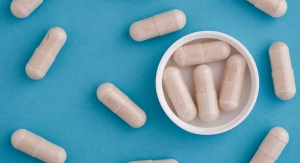Worldwide, approximately 10% of men in their 30s, 20% of men in their 40s, 50-60% of men in their 60s, and 80-90% of men in their 70s and 80s encounter BPH.2 The diagnosis and treatment of BPH has been assessed to be the largest segment of urologic practice, representing 23% of the total visits and 12.2 million men suffering from BPH being managed each year in the U.S.3
Various medical treatments are currently available, but natural alternatives also exist, such as saw palmetto, nettle roots, Pygeum africanum, pumpkin seed oil, etc. A saw palmetto hexanic extract has been shown to be as effective as medication and without side effects.4
Vi-spoTM, the Vidya Herbs innovative saw palmetto extract, is obtained from non-GMO Serenoa repens ripe berries grown without pesticides, using a 100% green CO2-SC extraction process and chromatographic purification (Nnew state-of-the-art saw palmetto production plant in Florida).
Vi-spo™ is naturally enriched in beta-sitosterol (up to 3%) and is an oil extract with no solvents or carriers (85-95% fatty acids). Vi-spo™ was recently granted a U.S. patent.5
Vi-spoTM exerts its beneficial activity through three complementary mechanisms of action:
- Inhibition of the 5 α-reductase activity to reduce the transformation of testosterone in dihydrotestosterone;
- Modulation of the prostate cells apoptosis, promoting the regular renewal that can slow down the prostate growth;
- Modulation of inflammation, a reduction of risks factors associated with cancer development.6
Due to its specific mechanisms of action, Vi-spoTM can be a suitable natural solution for androgenic alopecia (clinical on going).
Vi-spoTM efficacy was demonstrated in a double-blind, randomized, placebo-controlled clinical trial.7 The comparison of Vi-spoTM with a conventional saw palmetto extract and a placebo was conducted with 99 male subjects (40 to 65 years old) for 84 days. The subjects consumed either 200 mg Vi-spoTM (VISPO), 200 mg of traditional saw palmetto extract (SPO), or 200 mg placebo, twice daily.
Symptom assessment was performed by the International Prostate Symptom Score (IPSS), the Aging Male Symptom (AMS) scale, and with the Androgen Deficiency in the Aging Male (ADAM) questionnaires. The global quality of life was assessed with the SF-12 questionnaire. The evolution of BPH, urine flowmetry, and postvoid residual urine volume (PVR) were measured.
At the end of the study, a significant reduction from the baseline of the IPSS score (-3.18±3.14 p<0.05) was only observed in the VISPO group. A non-significant (-0.91±3.34 p>0.05) reduction was noticed in the SPO group. These results were confirmed by the ADAM questionnaire, which revealed a significant reduction (-0.61±1.06 p<0.05) for the VISPO group. This score was increased for the SPO (+0.06±0.90 p>0.05) and the placebo (+0.15±0.94 p< 0.05) groups. The AMS scale also confirmed efficacy by a significant reduction (-3.64±4.76 p<0.05) from the baseline in the VISPO group, while a non-significant reduction (-1.12±4.14 p>0.05) was observed in the SPO group, and a non-significant increase (+1.70±3.37 p>0.05) was observed in the placebo group.
Figure 1: Symptoms Scores (*: p<0.05)
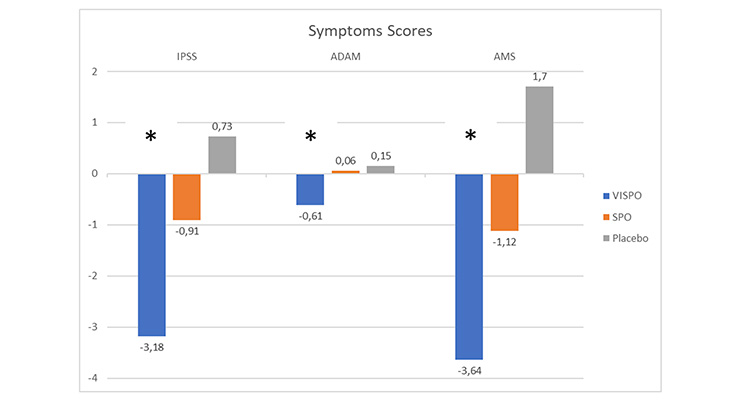
The perceived benefits or improvements experienced by the subjects revealed through the formal questionnaires were confirmed by the improvement of the instrumental physiological assessments, the Post Residual Urine Volume (PRV), and the urine flowmetry.
A significant reduction from the PRV baseline was only observed in the VISPO group (-12.76±14.44 p<0.05), whereas a non-significant reduction was observed in the SPO group (-1.88±10.93 p>0.05). A significant increase in the PVR was observed in the placebo group (+1.11±13.89 p>0.05).
Figure 2: Post Residual Volume (ml) (*: p<0.05)
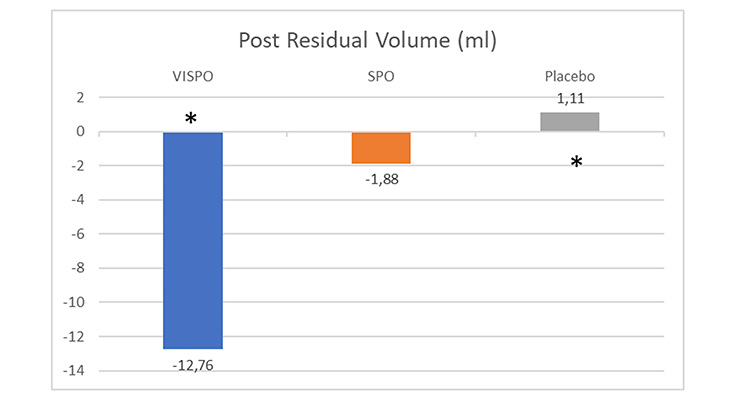
Very consistently, the improvement of the bladder-voiding capacity was confirmed by the urine flowmetric assessment of the maximum urine flow rates, which indicates an improvement of the bladder capacities.
Confirming the improvement of the symptoms scores and the PRV, a significant improvement of the maximum urine flow rate was observed in the VISPO group (+2.42±2.61 p<0.05), while a non-significant smaller improvement was observed in the SPO group (+0.48±1.56 p>0.05). The placebo group showed a non-significant reduction in the maximum flow rate (-0.64±2.28 p>0.05).
Figure 3: Flowmetry (*: p<0.05)
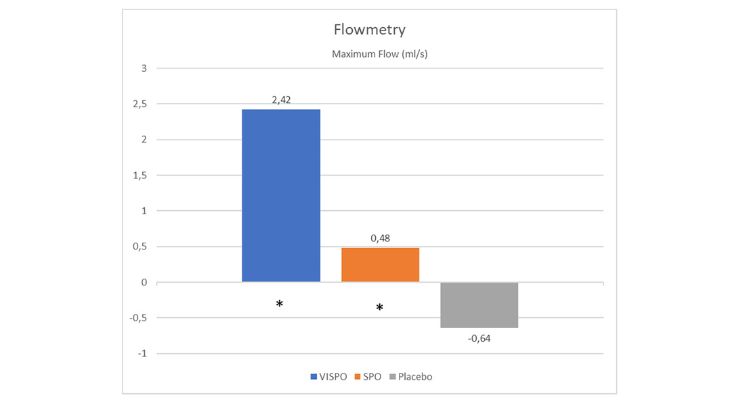
The improvement in the symptoms scores, the PRV and the urine flowmetry show how Vi-spo™ helps improve the physiology of men with BPH.
This physiological change should then improve the quality of life. This was demonstrated as follows.
The improvement of the quality of life was assessed by SF-12 questionnaire, and the total score significantly improved in the VISPO group (+1.81±1.97 p<0.05), whereas a smaller significant improvement was recorded in the SPO group (+0.45±1.73 p<0.05). A non-significant decrease in quality of life was observed in the placebo group (-0.76±1.79 p>0.05)
Figure 4: Quality of Life Score SF-12 (*: p<0.05)
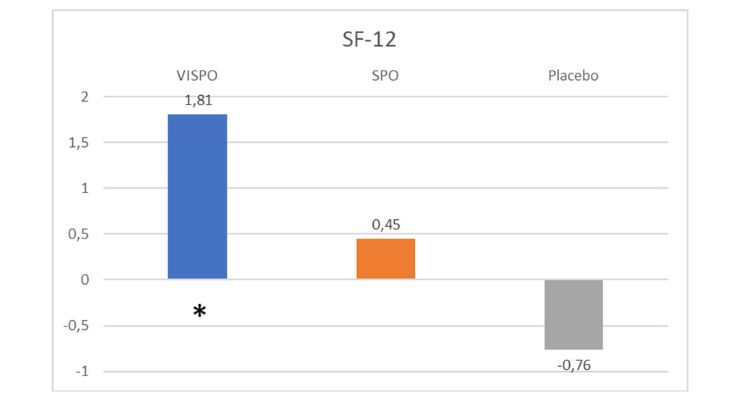
In the trial, specific BPH markers were assessed to confirm the lab experiments.
For the BPH markers, the serum levels of PSA decreased in the VISPO group from 2.77 ± 0.56 ng/mL to 2.70 ± 0.59 ng/mL while they increased in SPO and placebo groups after the treatment. The subjects in VISPO group showed an increase in free testosterone levels (6.23 ± 1.16 to 6.46 ± 1.43) after treatment (p < 0.05).
In contrast, there was a reduction of serum levels of free testosterone in SPO and placebo groups. The change in free testosterone from baseline to end of treatment was significant in VISPO group compared to placebo (p < 0.05). There was a reduction in total testosterone noted in all the treatment groups. However, the data were not significant. 5α-reductase activity was non-significantly reduced in VISPO group from baseline to the end of the 12-week treatment (445.90 ± 105.40 ng/L to 438.24 ± 98.56). However, it was noticed that unexpectedly, the enzyme activity increased in SPO group towards the end of study.
The results of the clinical trial described above demonstrated that Vi-spo™, the Vidya Herbs saw palmetto extract enriched with beta-sitosterol, is more effective than a conventional extract to treat BPH and increase comfort in mature men. Vi-spo™ is also a much more powerful ingredient for the healthy life of mature men.
Indeed, it demonstrated by restoring physiological urinary and hormonal functions and by improving BPH manifestations, the improvement of sex life, mood, and wellbeing of mature men.
By restoring their urinary comfort and virility, Vi-spo™ both restores a sense of self-confidence and contributes to men’s healthy and comfortable aging.
*These statements have not been evaluated by the Food and Drug Administration. This product is not intended to diagnose, treat, cure or prevent any disease.
References
1. Bortnick EM, Simma-Chiang V, Kaplan SA., Long-term Consequences of Medical Therapy for Benign Prostatic Hyperplasia., Rev Urol. 2019;21(4):154-157.2. Roehrborn CG., Benign prostatic hyperplasia: an overview., Rev Urol. 2005;7 Suppl 9:S3-S14.
3. Vuichoud C, Loughlin KR., Benign prostatic hyperplasia: epidemiology, economics and evaluation., Can J Urol. 2015 Oct;22 Suppl 1:1-6.
4. Alcaraz A, Carballido-Rodríguez J, Unda-Urzaiz M, Medina-López R, Ruiz-Cerdá JL, Rodríguez-Rubio F, García-Rojo D, Brenes-Bermúdez FJ, Cózar-Olmo JM, Baena-González V, Manasanch J., Quality of life in patients with lower urinary tract symptoms associated with BPH: change over time in real-life practice according to treatment--the QUALIPROST study., Int Urol Nephrol. 2016 May;48(5):645-56.
5. US 11,559,532;Composition and method for promoting normal urinary function, Jan. 24, 2023
6. Sudeep HV, Venkatakrishna K, Amrutharaj B, Anitha, Shyamprasad K., A phytosterol-enriched saw palmetto supercritical CO2 extract ameliorates testosterone-induced benign prostatic hyperplasia by regulating the inflammatory and apoptotic proteins in a rat model., BMC Complement Altern Med. 2019 Oct 17;19(1):270
7. Sudeep HV, Thomas JV, Shyamprasad K. A double blind, placebo-controlled randomized comparative study on the efficacy of phytosterol-enriched and conventional saw palmetto oil in mitigating benign prostate hyperplasia and androgen deficiency. BMC Urol. 2020 Jul 3;20(1):86. doi: 10.1186/s12894-020-00648-9. PMID: 32620155; PMCID: PMC7333342.





